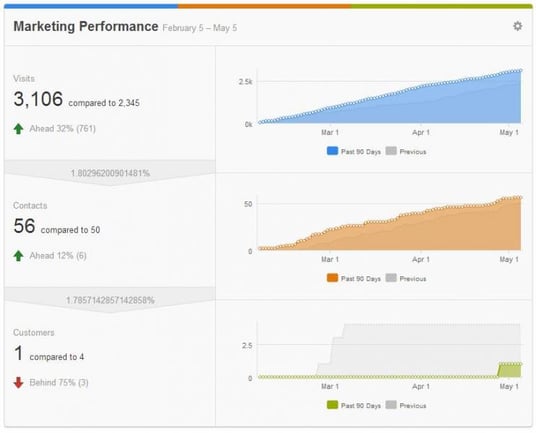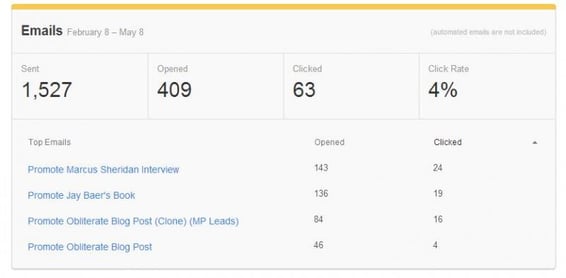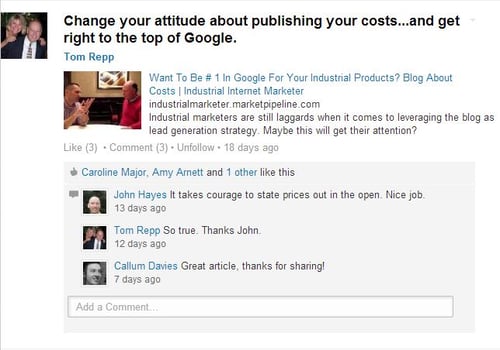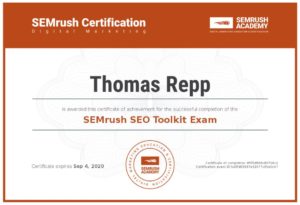 I was cruising down I-94 yesterday heading to Chicago to visit a customer and thinking about the overwhelming disruption our industrial internet marketing friends have had to deal with the last several years. Then it dawned on me, within a half generation or so the industrial buyer will have never known a market without access to your company’s information at any time via a mobile device.
I was cruising down I-94 yesterday heading to Chicago to visit a customer and thinking about the overwhelming disruption our industrial internet marketing friends have had to deal with the last several years. Then it dawned on me, within a half generation or so the industrial buyer will have never known a market without access to your company’s information at any time via a mobile device.
I thought to myself that is a remarkable statement. Are industrial marketers really prepared for all this disruption?
Not even close!
Industrial marketers continue to cling to their old ways. That is just human nature.
To illustrate my point, I did arrive at my customer’s business. I did a presentation on changing market realities and specifically the impact disruptive technologies would have on my customer’s business. I pointed out that if they continued their current “non-strategy” they risk the following:
- Losing competitive advantage they have enjoyed for years
- Losing top-of-mind awareness they have enjoyed for years
- Lost opportunities they will not even be aware of
- Stalled growth and lose of market share in a very niche industry
They were impressed with the presentation and information I gave them and all agreed they needed to change and do a better job of leveraging the web for lead generation and branding.
Then the owner says, “Marketing has always been our weak spot. But, I think we are going to complete a direct mail campaign we started” Isn’t that the definition of insanity?
So…I thought what a great blog post this experience provided. I decided to write a blog post comparing traditional industrial marketing versus digital industrial marketing. Fair warning, this post takes a more strategic and holistic view of the differences between traditional industrial marketing and digital industrial…some would call it inbound industrial marketing or content industrial marketing. For the engineers in the audience, don’t look for a lot of numbers.
First, let’s define traditional industrial marketing. Here is a short list of traditional industrial marketing activities we all know and love. Well, most of us.
- Press releases via trade journals
- Advertising
- Tradeshows
- Catalogs
- Direct mail
- Telemarketing
You might even include the old style e-mail marketing…”batch & blast”, with no strategy focus or market segmentation. Live cold calling might even be considered a marketing activity because you simply are canvasing businesses for a quality lead. Sales activity comes later.
Now…what activities are included in our digital marketing definition?
- Search
- Social Media
- Web site
- Blog
- Webinars
- Industry/company related content
- Keyword-specific/product specific landing pages
- Lead nurturing e-mail
Possibly you can include a marketing automation platform (MAP) such as HubSpot, Pardot or Eloqua in your bag of digital tricks.
I am not advocating dumping traditional industrial marketing. If it works use it. However, it is undeniable that the way your customer makes buying decisions has changed. Chances are your go-to-market strategy has not. If you are reading this you’re intellectually comparing your traditional marketing efforts to all the shiny & new stuff you are reading about and hearing about from your buddies at “The Club”, fellow marketers at trade shows, industry group speakers/presentations, etc.
Your customer’s behavior:
Let’s start with your customer. No…take that back, let’s start with you. Think of the last time you dug deep into the web for a product or service. For example, I recently had my Denon A/V receiver take a dump. Within 20 minutes I had read reviews, decided on specs and priced a new A/V receiver for my home entrainment system. Within two hours I had a new Yamaha RX-575 from Best Buy ready to set up. The entire process took about 4 hours from start to finish. Later the next day, I had assembled my new system. With all the new HDMI standards and cabling I needed some help. Most of my set-up was done late at night so Nancy would not hear me “talk to the equipment”. Sure enough, Yamaha had a 24 hour help line I could actually understand and they were extremely helpful.
I am sure you have had a similar experience. Your buyers’ behavior has changed. I used to go to Classic Stereo in Kalamazoo every Christmas and purchase a new component from Jim Stevenson to keep my system up to date. Often I would run into questions and drive back to the store and Jim was always there to help me. Of course, Classic Stereo is loooonnnng gone. (As ‘ol Ernie Harwell would say)
I know you can tell a similar story. Your customers can tell a similar story.
So, why hasn’t your go-to-market strategy changed around your buyers habits?
Measurement/metrics:
There are so many ways to measure your digital content marketing efforts I will not go into depth here. All these services are web-based. Almost all have a free trial you can try out. Although social media is not entirely mainstream for the industrial market, I predict it will as your younger buyer relies on social media for information about your industrial company as well as a convenient way to provide “talk back”…both positive and negative.
Hootsuite is just one example. Hootsuite’s tag line is, “Schedule, Manage. Measure”. Hootsuite is a web-based social media management system started in 2008. The software allows you to integrate your twitter, Facebook, LinkedIn, Google+ accounts into one, easily managed, dashboard. Based on the “freemium” pricing model, Hootsuite is terrific if all you need is brand management on the social networks.
If you want to take measurement to a higher plane then you need to look at MAPs, or marketing automation platforms such as Pardot (now owned by Saleforce.com), Eloqua (now owned by Oracle), Marketo, HubSpot, etc. MAPs have become the hottest thing since Google (well…maybe sliced bread). As you see from recent acquisitions there is a great deal at stake in the MAP sector.
The primary reason these platforms are so hot is really simple…they work. With your buyer now going to the web for all information about your products and services, it just makes sense to manage and measure all your online activity. MAPs are great at that.
If you want more in depth information about these platforms you can read my friend Marcus Sheridan’s post Marketo vs Eloqua vs Pardot. Marcus is a HubSpot “guy” but has done a fine job of posting an objective review of HubSpot’s competitors. By reading Marcus’s post and even trying a “Free Trail” or two you will get an idea of the amazing ability of MAPs to measure what works and what does not work for your online marketing efforts.
Here is just a sampling of the type measurement (or metrics) I get using our HubSpot license.

(Above is the primary report we are interested in. How many visits, how many leads and how many of those leads turn into customers?)

(Above is e-mail marketing report from HubSpot)
Having these tools for measurement have been fantastic and helps me quickly see what inbound marketing activity is having the most impact on my web traffic.
The days of deploying MailChimp or Constant Contact for e-mail campaigns, Google Analytics for traffic data and Blogger or WordPress to manage your blog, and another platform to manage you social networks, in my opinion, are over. These MAPs help manage the content chaos and most importantly measure everything.
Here is the great irony of HubSpot for me. The part that you cannot measure has been the largest benefit of all…the intangibles. I wrote a post about this a few months ago.
How much is your marketing staff managing all the content that Google now requires? Can you consolidate and manage all the marketing elements by moving to a MAP?
Always-on marketing:
The fact is your customers are not waiting around for your next ad campaign, direct mail piece or your salesman’s cold call. No, the want their information right now…at their fingertips on a mobile device. In today’s digital world it is best to insure your content is “always-on” and available when your customer raises his hand and says, “help”. Your “always-on” B2B lead generation strategy should include online marketing assets that can answer any question your customer might have about your product or service.
For example, several weeks ago I posted an article titled, How Much Does an Industrial Web Site Really Cost? As you can see I am still getting comments on my article I posted to many Linkedin Groups, including Digital Marketing for Engineers where there are 2,300 members. I get “comments” all the time from articles I posted a year ago.

(From a Linkedin Group I am a member of, Digital Marketing for Engineers.)
Now that I convinced you (Have I?) the need to examine your go-to-market strategy, keep in mind that many of your traditional marketing efforts can drive significant traffic to your web site, blog, white paper or e-book. For example, one the best ways to get traffic to my blog is simply mentioning it to a prospect or customer. Many times I take them right to my blog site in their office and have them “subscribe”. Or, when talking to a prospect on the phone I always follow up with a personalized e-mail that provides at least 2 links to posts on my blog that are related specifically to our conversation.
Is your industrial marketing always-on?
Is your industrial marketing keeping up with your customer?
Maybe you are ready to raise your hand and say “Help”. Click the graphic below for a COMPLIMENTARY 30 minute consultation.
Author:Tom Repp
A passionate marketer attempting to change the way industrial marketers leverage the web as a growth-oriented, lead generation machine. View all posts by Tom Repp




